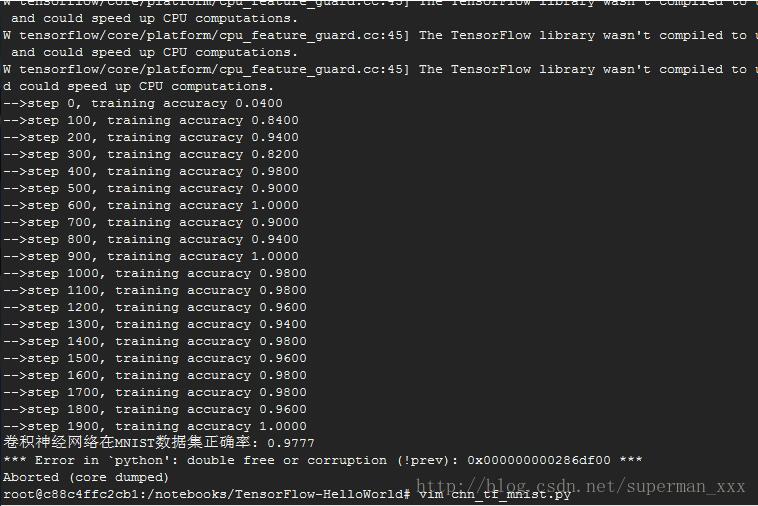本文实例为大家分享了TensorFlow实现卷积神经网络的具体代码,供大家参考,具体内容如下
代码(源代码都有详细的注释)和数据集可以在github下载:
|
1
2
3
4
5
6
7
8
9
10
11
12
13
14
15
16
17
18
19
20
21
22
23
24
25
26
27
28
29
30
31
32
33
34
35
36
37
38
39
40
41
42
43
44
45
46
47
48
49
50
51
52
53
54
55
56
57
58
59
60
61
62
63
64
65
66
67
68
69
70
71
72
73
74
75
76
77
78
79
80
81
82
83
84
85
86
87
88
89
90
91
92
93
94
95
96
97
|
# -*- coding: utf-8 -*-'''卷积神经网络测试MNIST数据'''#########导入MNIST数据########from tensorflow.examples.tutorials.mnist import input_dataimport tensorflow as tfmnist = input_data.read_data_sets('MNIST_data/', one_hot=True)# 创建默认InteractiveSessionsess = tf.InteractiveSession()#########卷积网络会有很多的权重和偏置需要创建,先定义好初始化函数以便复用######### 给权重制造一些随机噪声打破完全对称(比如截断的正态分布噪声,标准差设为0.1)def weight_variable(shape): initial = tf.truncated_normal(shape, stddev=0.1) return tf.Variable(initial)# 因为我们要使用ReLU,也给偏置增加一些小的正值(0.1)用来避免死亡节点(dead neurons)def bias_variable(shape): initial = tf.constant(0.1, shape=shape) return tf.Variable(initial)########卷积层、池化层接下来重复使用的,分别定义创建函数######### tf.nn.conv2d是TensorFlow中的2维卷积函数def conv2d(x, W): return tf.nn.conv2d(x, W, strides=[1, 1, 1, 1], padding='SAME')# 使用2*2的最大池化def max_pool_2x2(x): return tf.nn.max_pool(x, ksize=[1, 2, 2, 1],strides=[1, 2, 2, 1], padding='SAME')########正式设计卷积神经网络之前先定义placeholder######### x是特征,y_是真实label。将图片数据从1D转为2D。使用tensor的变形函数tf.reshapex = tf.placeholder(tf.float32, shape=[None, 784])y_ = tf.placeholder(tf.float32, shape=[None, 10])x_image = tf.reshape(x,[-1,28,28,1])########设计卷积神经网络######### 第一层卷积# 卷积核尺寸为5*5,1个颜色通道,32个不同的卷积核W_conv1 = weight_variable([5, 5, 1, 32])# 用conv2d函数进行卷积操作,加上偏置b_conv1 = bias_variable([32])# 把x_image和权值向量进行卷积,加上偏置项,然后应用ReLU激活函数,h_conv1 = tf.nn.relu(conv2d(x_image, W_conv1) + b_conv1)# 对卷积的输出结果进行池化操作h_pool1 = max_pool_2x2(h_conv1)# 第二层卷积(和第一层大致相同,卷积核为64,这一层卷积会提取64种特征)W_conv2 = weight_variable([5, 5, 32, 64])b_conv2 = bias_variable([64])h_conv2 = tf.nn.relu(conv2d(h_pool1, W_conv2) + b_conv2)h_pool2 = max_pool_2x2(h_conv2)# 全连接层。隐含节点数1024。使用ReLU激活函数W_fc1 = weight_variable([7 * 7 * 64, 1024])b_fc1 = bias_variable([1024])h_pool2_flat = tf.reshape(h_pool2, [-1, 7*7*64])h_fc1 = tf.nn.relu(tf.matmul(h_pool2_flat, W_fc1) + b_fc1)# 为了防止过拟合,在输出层之前加Dropout层keep_prob = tf.placeholder(tf.float32)h_fc1_drop = tf.nn.dropout(h_fc1, keep_prob)# 输出层。添加一个softmax层,就像softmax regression一样。得到概率输出。W_fc2 = weight_variable([1024, 10])b_fc2 = bias_variable([10])y_conv=tf.nn.softmax(tf.matmul(h_fc1_drop, W_fc2) + b_fc2)########模型训练设置######### 定义loss function为cross entropy,优化器使用Adam,并给予一个比较小的学习速率1e-4cross_entropy = tf.reduce_mean(-tf.reduce_sum(y_*tf.log(y_conv),reduction_indices=[1]))train_step = tf.train.AdamOptimizer(1e-4).minimize(cross_entropy)# 定义评测准确率的操作correct_prediction = tf.equal(tf.argmax(y_conv,1), tf.argmax(y_,1))accuracy = tf.reduce_mean(tf.cast(correct_prediction, tf.float32))########开始训练过程######### 初始化所有参数tf.global_variables_initializer().run()# 训练(设置训练时Dropout的kepp_prob比率为0.5。mini-batch为50,进行2000次迭代训练,参与训练样本5万)# 其中每进行100次训练,对准确率进行一次评测keep_prob设置为1,用以实时监测模型的性能for i in range(1000): batch = mnist.train.next_batch(50) if i%100 == 0: train_accuracy = accuracy.eval(feed_dict={x:batch[0], y_: batch[1], keep_prob: 1.0}) print "-->step %d, training accuracy %.4f"%(i, train_accuracy) train_step.run(feed_dict={x: batch[0], y_: batch[1], keep_prob: 0.5})# 全部训练完成之后,在最终测试集上进行全面测试,得到整体的分类准确率print "卷积神经网络在MNIST数据集正确率: %g"%accuracy.eval(feed_dict={ x: mnist.test.images, y_: mnist.test.labels, keep_prob: 1.0}) |

以上就是本文的全部内容,希望对大家的学习有所帮助,也希望大家多多支持服务器之家。
原文链接:https://blog.csdn.net/superman_xxx/article/details/63351947










